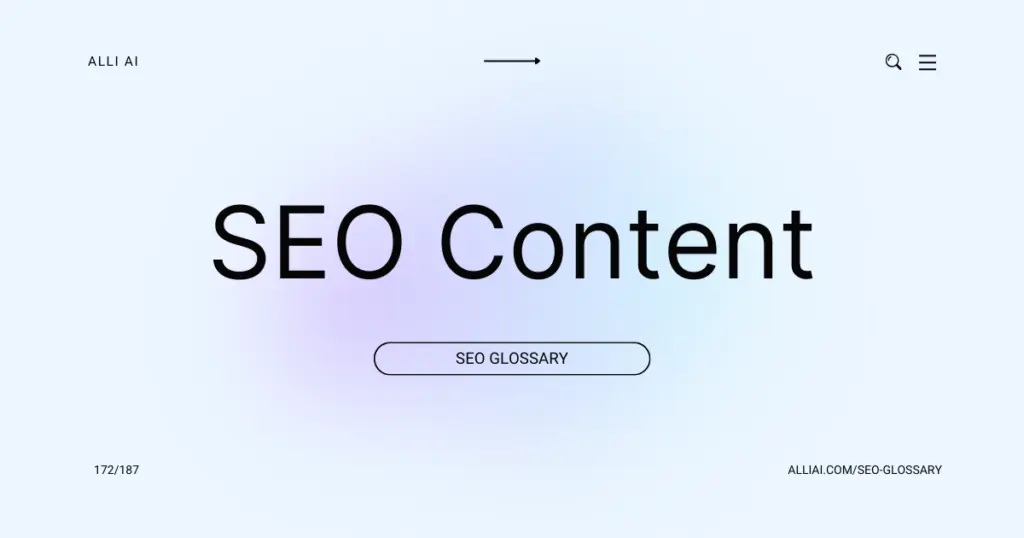What Does SEO Content Mean?
SEO content is material created for the purpose of improving the visibility of a website in search engines. It is designed to attract search engine traffic by incorporating specific keywords, high-quality information, and user-friendly formatting to make the content easily discoverable and relevant to both search engines and users.
Where Does SEO Content Fit Into The Broader SEO Landscape?
SEO content is essential within the broader SEO landscape as it directly impacts both on-page and off-page SEO factors. On-page, it includes the strategic use of keywords, meta tags, and quality content creation that enhances user engagement and time spent on the site. Off-page, it influences link building and social media interaction, as quality content encourages shares and backlinks from other websites. Additionally, SEO content plays a critical role in technical SEO by optimizing website architecture for crawlability through structured data and improved site speed by optimizing media and content layout. This comprehensive integration ensures that SEO content is not just about keyword stuffing but enhancing overall site visibility and user experience.
Real Life Analogies or Metaphors to Explain SEO Content
1. SEO content is like a magnet in a sandbox, pulling the metal shavings (traffic) towards itself amidst all the sand (online content).
2. It can be likened to planting a tree in a large forest (the internet) and making sure that tree is the tallest so it catches the most light (visibility).
3. SEO content is a lighthouse for ships (internet users) in a vast ocean, guiding them safely to shore (your website).
4. It is the workout regimen for your website, making sure it’s fit enough to run faster and stand out in the race against other websites.
5. SEO content acts as a water filter, ensuring that only clean, relevant traffic flows through to your site, just like a filter ensures only clean water passes through.
6. Think of SEO content as a specialized key crafted to unlock a specific door (search engine algorithm) that leads to a room filled with potential customers.
7. It is like a chef seasoning a dish perfectly so it stands out in a taste test among hundreds of other dishes (websites) being judged (searched).
8. SEO content is similar to a street performer who strategically chooses a busy corner (keyword optimization), gaining the attention of more pedestrians (web users).
9. It’s like tailoring your outfit (content) perfectly for a high-profile party (the first page of search results) where impressions matter the most.
10. SEO content is similar to a treasure map, guiding users directly to the X (valuable information or products on your website), navigating through the vast island of the internet.
How the SEO Content Functions or is Implemented?
1. Keyword Research: Identify target keywords relevant to the content’s subject matter using SEO tools and analysis.
2. Content Creation: Develop well-structured, high-quality content that naturally incorporates target keywords without overstuffing.
3. On-Page Optimization:
– Include target keywords in title tags, meta descriptions, headers, and throughout the content.
– Optimize images with alt tags that include relevant keywords.
– Use a user-friendly URL structure that includes a keyword.
4. Content Organization:
– Use a logical hierarchy for information with clear headings and subheadings.
– Ensure content flows naturally and is easy to read.
5. User Engagement:
– Implement interactive elements (videos, clickable links, infographics) to increase user engagement and time on site.
– Use internal linking to relevant articles and pages on the website.
6. Mobile Optimization: Ensure the content is responsive and provides a good user experience on mobile devices.
7. Speed Optimization: Improve page load times by optimizing images and using fast hosting.
8. Use Schema Markup: Implement structured data to help search engines understand and display the content better in search results.
9. Social Sharing: Integrate social media sharing buttons to increase visibility and generate backlinks.
10. Performance Tracking:
– Use tools like Google Analytics and Search Console to track how well the content performs in terms of traffic, rankings, and conversions.
– Adjust strategy based on data collected.
11. Regular Updates: Periodically update content to keep it relevant and improve its ranking over time.
Impact SEO Content has on SEO
1. Keyword Targeting and Relevance: SEO content helps target specific keywords to improve relevance for search engine queries, aligning with user intent and increasing visibility in search results.
2. Quality and Value: High-quality, informative content satisfies user queries better, reducing bounce rates and encouraging longer dwell times, which are positive signals to search engines.
3. Content Freshness: Regularly updated content is viewed favorably by search engines, which often give preference to current, relevant content in ranking decisions.
4. User Engagement: Engaging content increases the likelihood of user interaction, including shares, comments, and extended browsing, which can signal to search engines that the content is valuable.
5. Internal Linking: Strategic use of internal linking in content helps in distributing page authority and ranking power throughout the site, and also helps in user navigation.
6. Site Structure and Content Hierarchy: Well-organized content that follows a logical structure improves the site’s crawlability and indexing, which boosts SEO performance.
7. Backlink Attraction: Quality content attracts backlinks from reputable sites, which enhances domain authority and directly influences rankings.
8. Conversion Optimization: Good content not only attracts users but can also lead them towards taking desired actions, such as subscriptions or purchases, thus affecting conversion rates positively.
9. Semantic Saturation: Proper use of relevant keywords, synonyms, and topics within content helps search engines understand the context better, leading to improved search engine results page (SERP) positions.
10. Accessibility: Content that is created with accessibility in mind (use of alt text for images, accessible media, simple language) reaches a wider audience and complies with SEO best practices, thus enhancing user experience and engagement.
11. Mobile Optimization: Content optimized for mobile devices ensures a better user experience for the growing number of mobile users, which is crucial since mobile-friendliness is a ranking factor for Google.
12. Voice Search Optimization: As voice search becomes more popular, including conversational keywords and FAQs in content can attract this segment of users, impacting SEO positively.
13. Local SEO Enhancement: For businesses targeting specific geographic regions, local keywords and locally relevant content can enhance visibility in local search results.
14. Long-tail Keyword Utilization: Incorporating long-tail keywords in content can capture more niche traffic with higher intent, often leading to better conversion rates.
15. Content Depth and Breadth: Comprehensive coverage of topics (covering breadth) and detailed exploration of topics (covering depth) signal to search engines that the website is an authoritative source on particular subjects.
SEO Best Practices For SEO Content
1. Identify Target Keywords: Research and identify primary and secondary keywords relevant to your content using tools like Google Keyword Planner or SEMrush.
2. Optimize Title Tags: Include the primary keyword naturally in the title tag of your page. Keep it under 60 characters.
3. Meta Description Revision: Write a compelling meta description incorporating the primary keyword. Limit it to 155-160 characters.
4. Headers and Subheaders: Use headers (H1, H2, H3) throughout your content. Include primary and secondary keywords appropriately without overstuffing.
5. Incorporate Keywords in Content: Naturally integrate primary and secondary keywords in the first 200 words, and throughout the text while maintaining readability.
6. Optimize Images: Use relevant images and include keywords in the file name and alt text.
7. Internal Linking: Include internal links to other pages on your website using relevant anchor texts.
8. External Linking: Link to credible external sources where appropriate; this can enhance the authority of your content.
9. URL Structure: Ensure the URL is concise and includes the primary keyword.
10. Mobile Optimization: Check that the web page is mobile-friendly.
11. Page Loading Speed: Optimize page loading times using tools like GTMetrix or Google PageSpeed Insights.
12. Use Schema Markup: Implement relevant schema markup to help search engines understand content context.
13. Social Media Sharing Options: Include buttons for easy social sharing.
14. Content Update: Regularly update the content to keep it fresh and relevant.
15. SEO Audit: Regularly perform an SEO audit to identify and rectify issues like broken links, duplicate content, and redirect errors.
Common Mistakes To Avoid
1. Keyword Stuffing: Avoid overusing keywords in your content to the point where readability and user experience are compromised. Instead, use keywords thoughtfully and sparingly within a natural flow.
2. Duplicate Content: Ensure all content on your site is original and not repeated across multiple pages or domains. Utilize canonical tags when necessary to point search engines to the original content.
3. Neglecting Meta Tags and Descriptions: Do not overlook meta tags and descriptions as they are important for SEO rankings. Make sure they are informative and include relevant keywords.
4. Ignoring URL Structure: Use SEO-friendly URLs that are simple, easy to read, and include keywords. Avoid long and confusing URLs with numerous parameters.
5. Failing to Optimize for Mobile: As mobile traffic increases, ensure your site is responsive and mobile-friendly. Google uses mobile-first indexing, making this imperative.
6. Lack of Quality Content: Do not produce content just for the sake of having more pages. Focus on high-quality, useful content that provides value to your audience.
7. Overlooking Image Optimization: Optimize all images by using descriptive filenames, reducing file size for faster loading, and adding alt text with relevant keywords.
8. Not Using Analytics to Track Performance: Not monitoring your SEO performance with tools like Google Analytics can leave you blind to what’s working and what isn’t. Regularly check and adjust your strategies based on data.
9. Ignoring Local SEO: If applicable, make sure to optimize your content for local search queries, include location-specific keywords, and maintain an up-to-date Google My Business profile.
10. Neglecting Backlinks: Focus on building quality backlinks instead of quantity. Poor quality backlinks can harm your SEO, so aim for those from reputable and relevant sources.
11. Slow Page Load Times: A slow website can hurt user engagement and SEO rankings. Optimize your site’s loading speed by compressing images, using caching, and minimizing code.
12. Forgetting about Semantic Search: Instead of focusing solely on keywords, consider related topics and terms for a broader and more effective SEO strategy. Use natural language that answers common queries related to your topic.
13. Skipping Header Tags: Proper use of header tags (H1, H2, etc.) helps organize content clearly for both search engines and users. Ensure headers include keywords and are used hierarchically.
14. Ignoring Social Media Signals: While not a direct ranking factor, social signals reflect content popularity and can drive traffic. Engage with your audience on social platforms and encourage sharing.
15. Placing Important Content Below the Fold: Ensure key information and calls to action are immediately visible without needing to scroll, enhancing user engagement and SEO.






